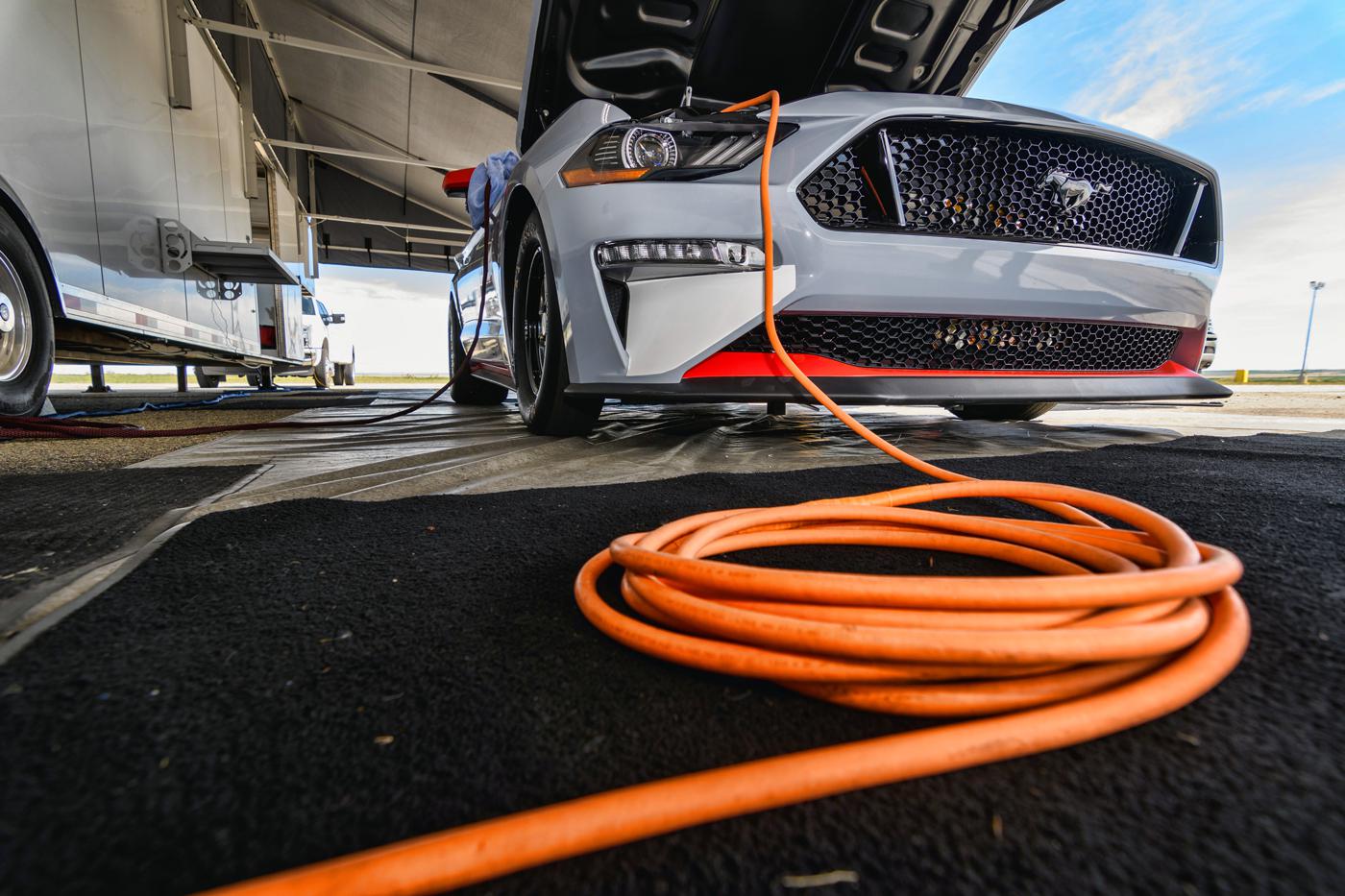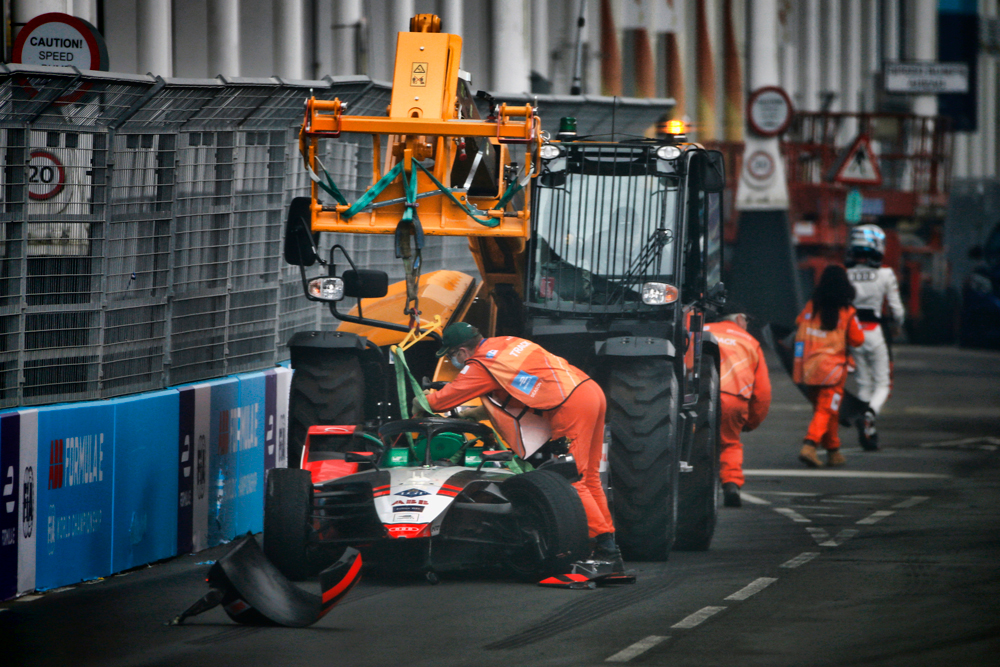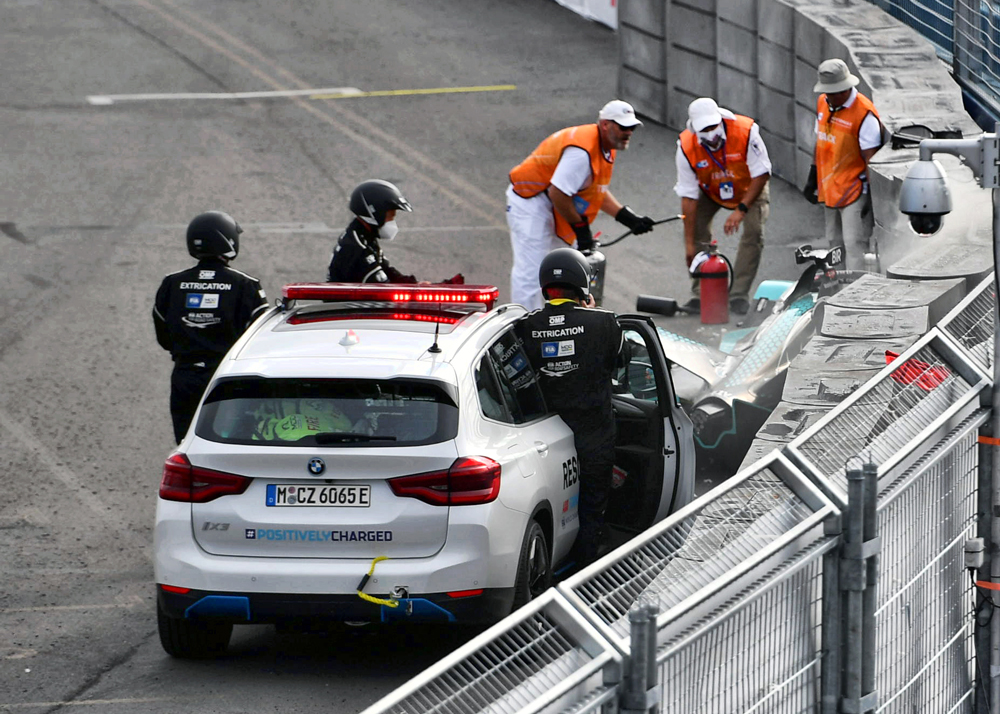How EVs Will Shape the Future of Motorsports Safety

Photo courtesy of Ford
Motorsports safety has primarily focused on internal-combustion vehicles. But with the growth of EV participation at every level of racing, these longstanding practices must evolve.
The inherent dangers of auto racing have been romanticized since the first two motorized carriages in town lined up against one another. It’s human nature to test our bravery and skill, to find joy in our successes in the face of peril. But thanks to a wide array of mechanical, technological and organizational changes implemented over the years, auto racing has become a far safer pursuit than it was even just a few decades ago.
Unfortunately, many of these advancements came as a result of incidents that revealed gaps in our knowledge about where potential deficiencies existed. As electric vehicles continue to find footing in motorsports, they’re rewriting the rules not only in terms of performance, but also safety. With a fundamentally different design and fuel source, EVs pose new challenges for teams, sanctioning bodies and racing facilities, many of whom have just begun to venture into this territory with minimal outside guidance.
“You don’t know what you don’t know,” noted Pete Fiset, a member of the International Council of Motorsport Sciences. “Right now, the industry is still figuring out a lot of this. Many of these different racing groups are taking their own approach to it and are creating their own solutions, but they’re not always sharing that information with everyone else. It would be a shame for everyone to have to experience the same problems on their own before they too can figure out how to make things safer.”
It’s also clear that a better understanding of some fundamental concepts, best practices and what the future may hold will help lay the groundwork for a safer racing environment. As EVs expand their footprint beyond one-make series and production stock classes in racing, it’s the sort of insight that will only become more valuable over time.
Taming A Different Beast
Mike Hurst of the SFI Foundation in Poway, California, said that it’s difficult to pinpoint specific best practices for EV safety in motorsports because trends (and standards they would necessitate) have not been established yet. But there are several key elements that are intrinsic to on-track electric vehicle safety as we know it today—as well as some inevitable challenges.
“For the majority of the programs we have, a lot of it would transfer over and be acceptable for use in an EV race car,” Hurst explained. “And I think there’s a parallel there if you look at, say, how local fire departments are equipping their staff and training for incident response with EVs. Many of the tools are the same. But much of EV motorsports in the US is still in the conceptual stage, and there are also things that we’re going to need to do differently. Things like specific fire suppression agents and standardized powertrain controls that would oversee thermal limits and the amount of current. To me, that’s going to be the toughest thing to manage. This is a safe propulsion system as long as OE-style controls are in place to provide safeguards against over-stressing the battery and things like that. But when put into a motorsport context, people are going to want to take everything to the limit. That’s what racers do.”
That presents issues that might not be detectable at a glance. “The dangers are usually obvious. You can see a fuel leak,” said John Fabijanic, SAE Faculty Advisor at Cal Poly San Luis Obispo in California. “I’m fairly comfortable having my students handling gasoline. I’m usually more concerned about high-temperature fluids like coolant and oil. Those worry me more because people are generally less cognizant of how to handle them, and I would put electricity in that same boat. But SAE has done a good job establishing those basic rules in terms of how we isolate it down into low and high voltage and breaking it down into non-dangerous modules.”
John Metric of the National Electric Drag Racing Association (NEDRA) in Houston, Texas, and owner of Lonestar EV Performance, said that while batteries are just another type of energy storage, their characteristics point to a change in procedure when it comes to incident response. “When ignited, liquid fuels are consumed very quickly. But a battery segregates electrons from one side of the accumulator to other side of it. As long as there’s not some uncontrolled way for those electrons to get from one side to the other, they’re fairly stable and safe. You could throw a match onto the battery and it’s not going to spontaneously explode. Where we generally run into issues is with physical punctures of the battery, overheat conditions, and individual component failures inside the system. The reaction is more like a fuse burning—the fuel doesn’t all go up at once. That typically provides time to evacuate the driver, and usually there’s time to move the vehicle off the track as well. But if minutes go by without doing anything to contain it, that small fuse can set the whole vehicle on fire.”
As Fiset explained, those fires can be much more difficult to extinguish than a blaze fueled by an internal-combustion vehicle. “Once thermal runaway sets in and the batteries catch fire, they can be very, very hard to put out,” he said. “We are used to dealing with alcohol or petroleum-based fires, but these fires can become self-supporting. Just removing oxygen and hitting it with a CO2 extinguisher won’t cut it sometimes. In some circumstances, these battery fires can require thousands of gallons of water to contain.”

The technology is improving, though, and Fabijanic told us that improvements in controlling thermal runaway are already being seen throughout the industry. Yet when things do escalate to that level, those situations don’t always line up with traditional best practices. “Those kinds of fires tend to run hot and release a lot of nasty chemicals, but the main issue is that they’re internally sustained. So you need ventilation and, ideally, you’d smother it. With a lithium-ion fire, there’s a kind of sand that contains specialized chemicals that are more effective at putting out those types of fires.”
Strategies For Success
Fabijanic also said that Formula 1, which incorporated a hybrid system into the race cars’ power units in 2014, is one of the series that’s leading the way in terms of protective equipment and operating procedures for EV technology in motorsports. “At this year’s British Grand Prix, for instance, there was a big crash and there was a significant delay before they moved the car because they were confirming that the high voltage system was disabled. The safety crew had the thick, high-voltage gloves on as well. The issue was that there was still a green light lit up on the roll hoop of the car, which indicates that the hybrid system is active. So they went through a series of checks, and none of the normal corner workers touched the car until it was deemed safe. This is how Formula 1 is handling it, and other series are going to have to consider implementing similar measures as they bring in this technology.”
Similar scrutiny should be applied to the designs of the race cars themselves. “DC current is always trying to find ground. Get between it and that ground and there’s the potential for electrocution,” Metric said. “The battery compartment and the driver’s compartment should always be separate to prevent any high voltage around the driver.
“Since the early days, NEDRA rules have specified a master cut-off switch that’s accessible by the driver as well as the track crew, so either one can disable the main power pack,” he continued. “The battery pack should also be held down to the car in such a way that it’s prevented from splitting apart and going in its own direction. Ultimately, you can plan for the worst, but wrapping yourself around a tree isn’t part of anyone’s plan. Fortunately, in drag racing you’re not really faced with a significant potential for meeting a fixed object perpendicularly like that.”
Hurst said that the prospect of using motorsports components that were designed for traditional race cars on electric vehicles also comes with some additional considerations. “EVs tend to be heavier, and that might change what’s going to work in a given application. A 4,500-pound vehicle is going to have a lot more crash energy than one that’s 3,000 pounds. That also applies to things like wheels: Putting a traditional skinny drag wheel on the front of an EV that was intended for a car that weighs half as much could present a problem. It’s a situation where the original manufacturer of the component just may not have envisioned that use case.”
The Shape Of Things To Come
It’s clear that at this early stage in EV motorsports’ development, many of the rules and standards are still being written. Unlike the last century of automotive development, this is not a situation where gradual refinement has plotted a clear course for everyone involved. Instead, this is really more of a reinvention in the context of motorsports, and that means that finding the right solutions will inevitably require some experimentation.
“You know, part of this is about figuring out how to manage these on-track incidents safely without telling everyone they have to go home because there’s a car burning up,” Hurst said. “I saw a story about a mobile water tank solution they’re trying in Germany, something you’d move around with a big truck. When they have a runaway thermal event with an electric car, they take that tank to the site, hook it to a fire hydrant to fill it up, and then drop the car in it. That might be a way to manage that. But then you have to consider that once that tank is filled, it’s not going anywhere—it’s just too heavy.”
Fabijanic said that before long, that approach might not be necessary. “It used to be a situation where if you did something wrong, it was fairly easy to get these batteries to run away,” he said. “But today’s batteries are far more robust. You have to really mess them up to set them into a runaway condition. Advances in battery chemistry have played a big part in that, as well as the packaging strategies that are now being used to address thermal issues. We also understand a lot more about how to keep them cool today, which is good for both safety and performance.”

Moreover, the wild card here isn’t necessarily the technology itself. “If racers have the freedom to make changes, they’re not going to take a conservative approach,” Hurst said. “So the big question is whether this technology makes sense for grassroots racing. This is pretty sophisticated stuff, and you worry about the guy who’s got just enough knowledge to be dangerous.”
Yet there also needs to be a balance that allows for innovation and meaningful competition. “It’s almost a marketing decision. Do we want people building their own cars at home and racing them, or are we trying to get unmodified cars out there?” Metric wondered. “If there’s no tuning involved, I think the appeal is going to be limited. I also think that with most innovations, it’s some sort of accident that leads to a rules change, and until there’s a problem that necessitates a new approach, the electric program is kind of wide open. But from a sanctioning body perspective, if something can be shown to significantly improve the situation, I’m all for it.”
Perhaps most importantly, with the financial backing and engineering resources of nearly the entire auto industry focused on EVs right now, they will continue to evolve at an incredibly rapid pace. “Eventually everything gets engineered to be safe, and innovations that are considered too expensive today might not be just a few years from now.” said Fiset. “Five years is like a lifetime with this technology.”
SOURCES
–
International Council of Motorsport Sciences
icmsmotorsportsafety.org
National Electric Drag Racing Association
nedra.com
SAE
sae.org
SFI Foundation
sfifoundation.com
 MEMBERSHIP LOGIN
MEMBERSHIP LOGIN JOIN PRI
JOIN PRI


